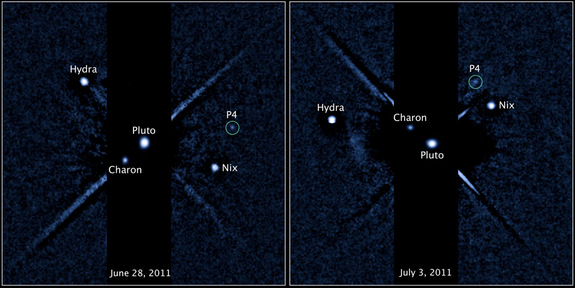Hell of a Choice: Cerberus Leads for New Pluto Moon Name

A fourth moon orbiting the dwarf planet Pluto has just been discovered. The tiny satellite — it's a mere 8 to 21 miles (13 to 34 km) across — showed up as a faint dot on new, long-exposure photos of the Pluto system taken by NASA's Hubble Telescope.
But enough with the technical details: What will we call the newest member of the solar community?
"It's called P4 for the time being," said Trent Perrotto, public affairs officer at NASA headquarters. "It'll get a name, but it's not up to NASA to decide on it." As usual with newly discovered astronomical objects, he explained, P4's name will be subject to a tough selection process overseen by an organization called the International Astronomical Union.
In an unofficial poll of SPACE.com readers, the top choice is "Mickey." Unfortunately for them, though, this won't satisfy the IAU's official naming conventions. According to the IAU guidelines, "Objects crossing or approaching the orbit of Neptune … notably [Pluto and its moons], are given mythological names associated with the underworld."
Pluto was the god of the underworld in Roman mythology. Charon, Pluto's largest moon, is named after the ferryman who carried the souls of the newly deceased across the River Styx, which divided the world of the living from that of the dead. Nix, Pluto's second moon, was the Greek goddess of darkness and night, and Charon's mother. Hydra, the third, was a many-headed serpent that guarded a back entrance to the underworld located deep below the surface of a lake. [Read: Why Doesn't Earth's Moon Have a Name?]
In choosing a name along these hellish lines for P4, the IAU nomenclature committee will try to honor the wishes of its discoverer: planetary astronomer Mark Showalter of the SETI Institute in California. What's his choice?
"This is a topic under discussion," Showalter told Life's Little Mysteries, a sister site to LiveScience. "We have a lot of colorful names to choose from because all the moon names come from, essentially, the minions of Hades [the Greeks' name for Pluto]. One name that seems to come up most is Cerberus, the dog who guards the gates to hell."
Get the world’s most fascinating discoveries delivered straight to your inbox.
Three-headed Cerberus is Hydra's sibling.
"Cerberus: How could you go wrong with a name like that?" Showalter said. "But, unfortunately, Cerberus is already the name of an asteroid. The IAU balks at the idea of using asteroid names, although it's not necessarily out of the question. Even then, Kerberos, [the spelling that] is closer to the original Greek, would be OK even if Cerberus is not. I don't want to say that's the name we've chosen. There are a lot of interesting names being discussed."
Showalter has been perusing the Internet today (July 20), looking for ideas. He and his discovery team will submit their top choices to the IAU soon, and he thinks they'll choose a name within two months. Perhaps Cerberus/Kerberos will soon be guarding the Kuiper Belt.
This article was provided by Life's Little Mysteries, a sister site to LiveScience. Follow us on Twitter @llmysteries, then join us on Facebook. Follow Natalie Wolchover on Twitter @nattyover.
Natalie Wolchover was a staff writer for Live Science from 2010 to 2012 and is currently a senior physics writer and editor for Quanta Magazine. She holds a bachelor's degree in physics from Tufts University and has studied physics at the University of California, Berkeley. Along with the staff of Quanta, Wolchover won the 2022 Pulitzer Prize for explanatory writing for her work on the building of the James Webb Space Telescope. Her work has also appeared in the The Best American Science and Nature Writing and The Best Writing on Mathematics, Nature, The New Yorker and Popular Science. She was the 2016 winner of the Evert Clark/Seth Payne Award, an annual prize for young science journalists, as well as the winner of the 2017 Science Communication Award for the American Institute of Physics.



